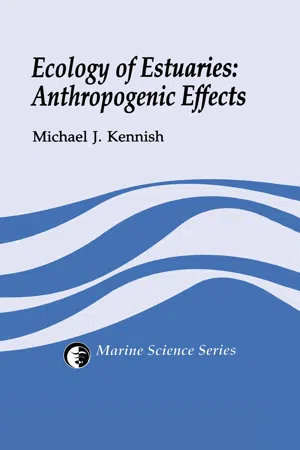
- 512 pages
- English
- ePUB (mobile friendly)
- Available on iOS & Android
About This Book
Ecology of Estuaries represents the most definitive and comprehensive source of reference information available on the human impact on estuarine ecosystems. The volume discusses both acute and insidious pollution problems plaguing these coastal ecotones. It also provides a detailed examination of the deleterious and pervasive effects of human activities on biotic communities and sensitive habitat areas in estuaries. Specific areas covered include organic loading, oil pollution, polynuclear aromatic hydrocarbons, chlorinated hydrocarbons, heavy metals, dredging and dredged-spoil disposal, radionuclides, as well as other contaminants and processes. The diverse components of these anthropogenic influences are assembled in an organized framework and presented in a clear and concise style that facilitates their understanding.
Frequently asked questions
Information
1 Organic Loading
Introduction
Eutrophication Problems
Sewage
Methods of Disposal
“…In the Outer Thames, nutrients are rapidly dispersed into water that is already substantially enriched and a very large area of enhancement results masking any local effects. In New York Bight, there is better dispersal into clean renewing water and, therefore, much less nutrient build-up, but the pattern of various highly polluted inputs creates highly variable water quality situations which, however, seldom achieve major plankton anomalies because of the rapidity of water renewal. In Liverpool Bay, dispersal is only moderate and highly variable but somewhat more persistent water quality anomalies are common. Since these are associated with some toxic or unfavorable conditions, phytoplankton development is poor and favors the growth of Phaeocystis, improving towards modest diatom growth when more offshore water types are present. At Garroch Head, dispersal is poor but the water is deep and the build up of nutrients in the water column is, therefore, much less. The low level of near-bottom turbulence retains much of the nutrients in the sludge to leak away slowly. Moderately enhanced phytoplankton and rich Zooplankton result.”
Sewage Sludge Composition
- Screening removes larger solids.
- A comminutor macerates so...
Table of contents
- Cover
- Title Page
- Copyright Page
- The Author
- Dedication
- Preface
- Table of Contents
- Introduction
- 1 Organic Loading
- 2 Oil Pollution
- 3 Polynuclear Aromatic Hydrocarbons
- 4 Chlorinated Hydrocarbons
- 5 Heavy Metals
- 6 Radioactivity
- 7 Dredging and Dredged-Spoil Disposal
- 8 Effects of Electric Generating Stations
- Index